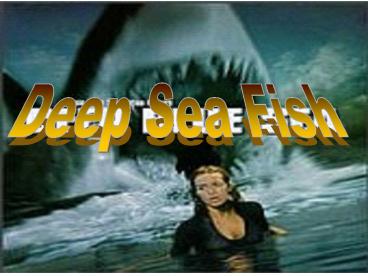Deep Sea Fish - PowerPoint PPT Presentation
1 / 23
Title:
Deep Sea Fish
Description:
Ranges from about 650-35,450 ft., starting from the edge of the continental shelf ... chimaeras- (a.k.a. ghost sharks) combination of sharks and rays, they have ... – PowerPoint PPT presentation
Number of Views:212
Avg rating:3.0/5.0
Title: Deep Sea Fish
1
Deep Sea Fish
2
The Deep Sea
- It is the largest environment on Earth
- Ranges from about 650-35,450 ft., starting from
the edge of the continental shelf - Has the strangest, and most interesting fish
inhabiting its area - 2 types of deep sea fish
- Pelagic- live in the mid-ocean (650-3,300)
- Benthic- live on, or near the deepest ocean
floors (below 3,300) - There are three zones of the deep sea
- Mesopelagic- (a.k.a. twilight zone) the remaining
blue-green light is gradually absorbed, into
darkness - Bathypelagic- complete darkness, but not the
deepest zone - Abyssopelagic- the absolute deepest, darkest
parts of the ocean
3
Common Characteristics
- Many of the fish that dwell in the depths of the
sea, have adapted common characteristics, that
have allowed them to survive in the harsh abyssal
conditions - large lateral line systems, which allow for
vibration detection - large sensitive eyes
- huge mouths
- specialized light organs
- fang-like teeth
4
Benthic Fish
- The most common type of benthic fish is the
rat-tails, which are related to cod fish - They have big, heavy heads, and long skinny tails
- Their heads have canals w/ contain long distance
lateral line organs - They use swim bladders, to make noises, to
communicate within their schools of fish, to stay
together - They have a barbel projecting from their chins,
which is used for sensing food on the muddy
bottoms - They have huge, sensitive eyes, with a large
abundance of rods, which are the light detecting
organs in the eye - These are not for detecting sunlight, because
there is none, but is for detecting the
bioluminescence of other deep sea animals - Adult rat-tails range in size from eight inches,
to three feet
5
Rattail Fish
6
Giant Rattail
7
Benthic Fish
- The next most common type of benthic fish is the
brotulid - They are similar in appearance to the rat-tails,
except for the size, and sensitivity of the eyes - They are more closely related to the blenny fish,
then cod, because they are live-bearers, and most
rat-tails lay eggs, like cod - Their lateral line organs are also less sensitive
then the rat-tails
8
Brotulid
9
Benthic Fish
- Some other types of benthic fish include
- ray fins- have elongated feelers, which extend
from their fins, but move independently, they are
used to find food, as well as move around on the
ocean floor, these compensate for their bad eyes - chimaeras- (a.k.a. ghost sharks) combination of
sharks and rays, they have claspers, and have
cartalaginous skeletons, they are very ancient
fish, and are very timid, despite their grotesque
appearance - flatfish- these include sole, flounder, and
halibut they dwell on the ocean floors, and can
easily blend in, using chromatophores, and by
borrowing into the sand
10
Pelagic Fish
- Pelagic fish have very strange adaptations, even
stranger then the benthic fish - One of the most successfully adapted types of
deep sea fish is the angler fish - They have long flexible appendages with light
organs on them, which extend from the tops of
their heads - They use these to lure prey within their reach,
and then they devour them - The light in these appendages is created by
luminous bacteria, that the angler fish can
stimulate by increasing the oxygen flow to the
area - The angler fish are odd-looking, lumpy creature,
and they have vicious fang-like teeth - Most anglers are either black or brown, and are
usually smaller then six inches long
11
Angler Fish
12
Angler Fish
13
Angler Fish
14
Pelagic Fish
- The most normal looking of all of the deep sea
fish are the lantern fish - They are grey or brown, and are shaped like the
common bony-fish - The differences between them and normal-looking
bony fish are their big eyes, and the rows of
luminescence, which line the sides of their
bodies - Like most deep sea fish, they are very small,
only around six inches long - Their name is given to them, because they have
the most spectacular bioluminescent abilities of
the deep sea fish
15
Lantern Fish
16
Pelagic Fish
- The viper fish, and dragon fish are types of
stomiatoids - These are slashing predators, with vicious fangs,
and huge mouths, they resemble baracudas, but
they are much more ferocious - They also have barbels extending from their
chins, which often look like long winding roots,
with many extensions off of them - These are used to lure prey, as in the angler
fish - Stomiatoids also have bioluminescence organs that
extend along their long bodies - Unlike the angler fish though, the stomiatoids
control these organs directly, not through
bacteria
17
Viper Fish
18
Viper Fishs' Light Organs
19
Dragon Fish
20
Pelagic Fish
- There are several other types of pelagic fish
- Hatchet fish are tiny fish (one or two inches),
that are shaped like hatchets, they have
telescopic eyes, and their tails are transparent - Giant-tails are long, skinny, metallic colored,
and tubular-eyed fish - Gulpers, a.k.a. pelican eels, are very strange
- They have huge mouths, long skinny bodies, and
expandable stomachs - They use their long tails to hold their prey, and
then they swallow them whole, no matter how large
they are, often larger then themselves
21
Hatchet Fish
22
Deep Sea Fish
- The vast differences in deep sea fish is very
obvious - The benefits of the seemingly strange
characteristics are obvious, they developed
things to allow them to survive without light
23
The
END

